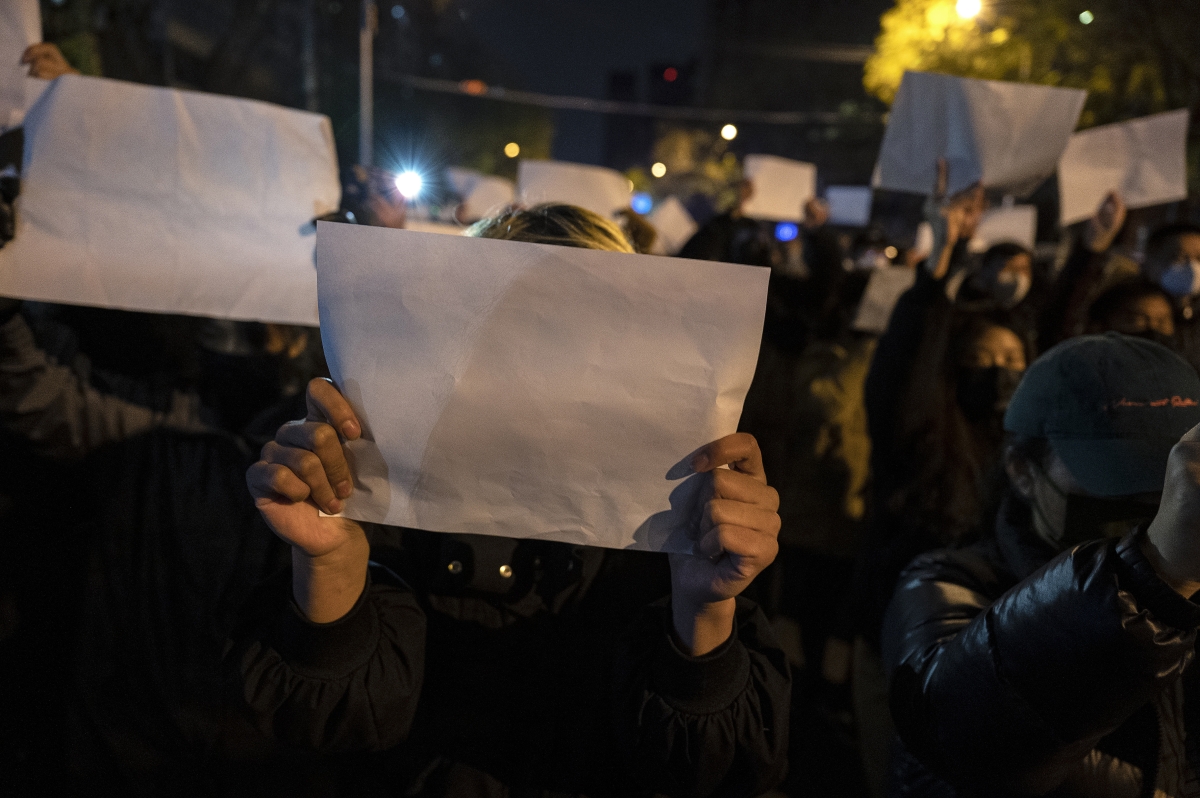One Year on From “White Paper” Protests, Disillusionment With China’s Government Persists

Just over a year ago, in November 2022, students and residents of major cities across China were raising blank sheets of paper and chanting slogans that included “Xi Jinping step down!” and “Down with the Chinese Communist Party!” These protests — which came to be known as the “White Paper” protests after the demonstrators’ ironic symbols of censorship and oppression — arguably posed the most direct challenge to the Chinese Communist Party (CCP) in decades. Not since the Tiananmen Square incident of 1989 had the CCP been confronted with such an openly defiant challenge to its authority.
Nor were these protests an isolated affair. After June 2022, hundreds of protests had already occurred in smaller cities across China, as people took to the street to vent their anger about the near total disruption of the economy by authorities’ draconian zero COVID restrictions. The second half of 2022 saw a restless society, frustrated with harsh COVID lockdowns, the needless sacrifice of income and lives from a nonsensical government policy that had no end in sight, and perhaps a more general anger against the direction of their country under CCP leadership.1
These protests had real influence. Soon after the eruption of the White Paper protests, Xi Jinping abruptly abandoned the zero COVID policy in early December 2022, a policy that had been steadfastly imposed for three years. Even though elite decision-making in China is a black box, the timing suggests that we can be fairly certain that the protests had succeeded in putting pressure on the party to change its course. Though there were certainly other relevant factors, including an economic slowdown, mounting local government deficits from Covid-containment spending, and the departure of foreign investors,2 the sudden change of course can be seen as a concession by the party to people’s demands — an extraordinary outcome created by the protestors.3
It is noteworthy, however, that the White Paper protests did not take place only in China. Chinese diasporas, mostly university students, in more than a dozen major cities across the world from Taipei, to London, to Amsterdam, to Toronto, and to Sydney organized their own demonstrations to support their compatriots at home.4
For many of these young people, in their early 20s, this was their first time taking part in protests of any kind. With slogans such as “We don’t want COVID tests, we want freedom!” “We want dignity!” and “United with the Uighurs, the people of Hong Kong and Taiwan!” the protests’ objectives were not necessarily aligned. They nonetheless represented a political awakening for many of their participants, as well as a political opportunity that brought together different stripes of anti-CCP elements. This is remarkable: since 1989 no single cause has been able to resonate with the people, let alone unite them across income strata, ethnic groups, and geographical regions. These were no longer just protests; they should more accurately be termed a “White Paper Movement” because they took place across geographical boundaries and were sustained over a significant period of time — hence, the CCP’s recognition that the unrest constituted the single greatest challenge to its rule in decades.
Today, the state has largely suppressed the White Paper protests. However for many citizens, their memory and meaning remain.5 Three years of zero COVID lockdowns and their sudden reversal, the subsequent shortage of medicines and excess deaths,6 and deep economic stagnation have shattered any illusions of state competence.7 In the absence of elections or public opinion polls, how do we know that people are losing faith in the system? The disgruntled are faced with two choices: exit or voice.8 By taking their anti-government grievances to the street, the Chinese people have already made their voices heard. Now, however, facing the high risk of government crackdowns, including arrest and harassment, many have opted for the exit option: the number of skilled Chinese people looking to migrate overseas and the wealthy looking for safer havens abroad to park their capital (such as Singapore) has risen dramatically since the pandemic.9
The challenges revealed by the White Paper protests do not necessarily mean the CCP will collapse anytime soon. It is entirely possible for the party to keep ruling the country while popular discontent persists. However, the CCP is facing strong headwinds in maintaining its grip on society since the abrupt end of the zero COVID policy. Declining economic growth rates, mounting local government debts, and a hostile geopolitical environment now pose further challenges to its capacity to maintain its power. This makes 2024 a particularly interesting year to watch for signs of the CCP’s continuing durability.
Endnotes
- Lynette Ong, “The CCP after the Zero-Covid Fail,” Journal of Democracy, 34(2), 32–46, April 2023.
- Yanzhong Huang, “China’s Hidden Covid Catastrophe: How Xi Obscured a Lethal Viral Wave – and What It Means for the Future of His Regime,” Foreign Affairs, February 16, 2023.
- Lynette Ong, “China’s Epidemic of Mistrust: How Xi’s COVID-19 U-Turn Will Make the Country Harder to Govern,” Foreign Affairs, January 11, 2023.
- Huizhong Wu and Dake Kang, “One Year After Protests Shook China, Participants Ponder the Meaning of the Brief Flare of Defiance,” Associated Press, November 27, 2023.
- Luo Minmin, “The Epidemic Will Eventually End, But How Should We Deal with Social Depression?”, The Intellectual (Zhishi Fenzi), November 30, 2022. Translated by David Ownby, Reading the China Dream.
- At one stage, death rates were so high in Shanghai that the city ran out of coffins, prompting families to pay funeral scalpers to secure one. See: “Shanghai Police Has Arrested Several Funeral Middlemen” (Shanghai Jingfang Zhuahuo Duoming Binzang Huangniu), January 1, 2023.
- The Economist, Chaguan, “China’s Economy Is Suffering from Long Covid,” November 30, 2023.
- Albert O. Hirschman. Exit, Voice, and Loyalty: Responses to Decline in Firms, Organizations, and States. Cambridge, MA: Harvard University Press, 1970.
- Ong, “The CCP after the Zero-Covid Fail,”. Net foreign investment into China registered an outflow of $11.8 billion in the third quarter of 2023, reversing its positive trend that has been maintained for decades. (Reuters, “China's first deficit in foreign investment signals West's 'de-risking' pressure”, November 6, 2023.) In 2022 alone, an estimated 10,800 wealthy Chinese left the country, many destined for Singapore. (Jason Douglas, Keith Zhai, and Stella Yifan Xie, “As China Opens, Flight of Wealthy Chinese to Singapore Set to Accelerate,” Wall Street Journal, 27 February 2023.)

